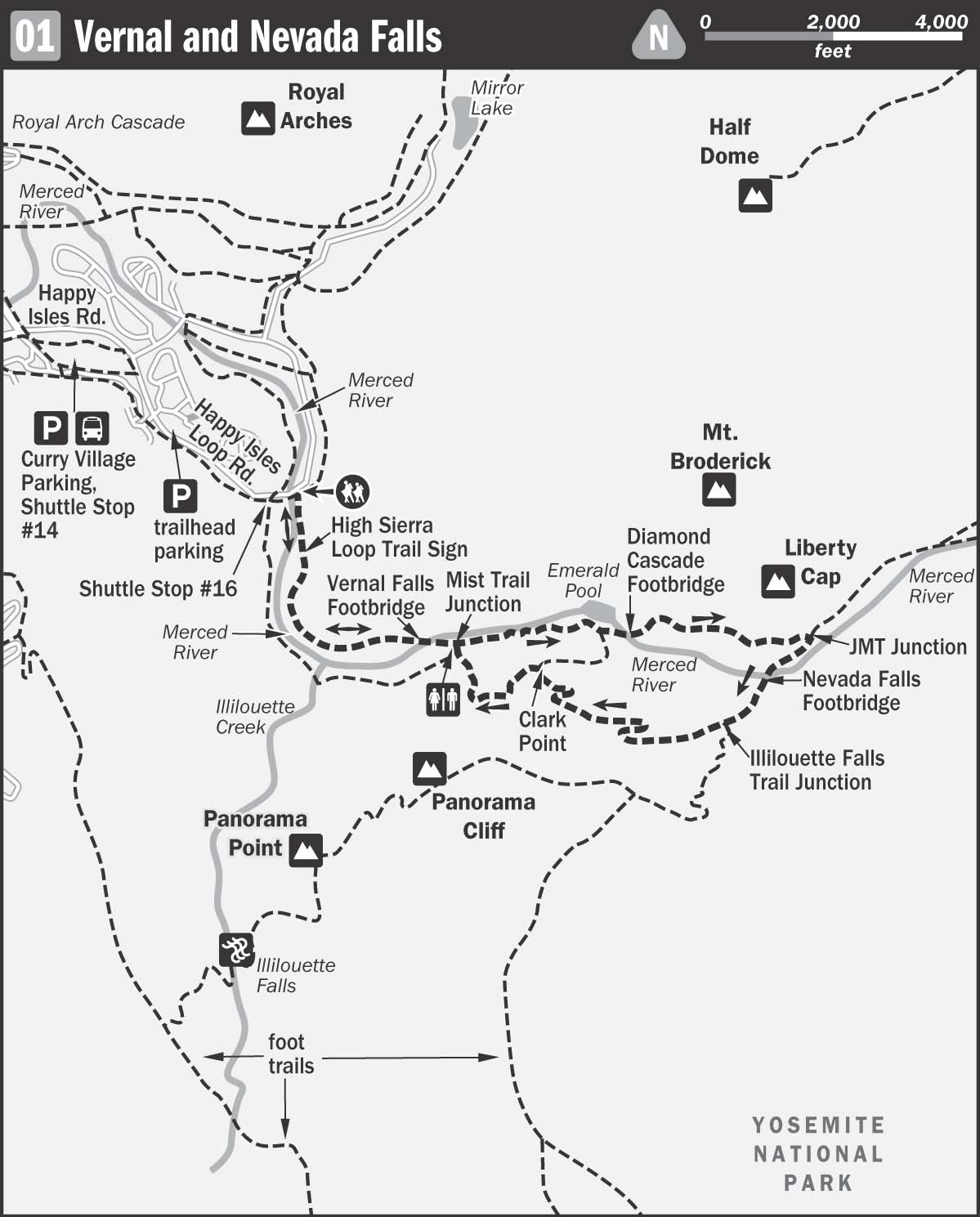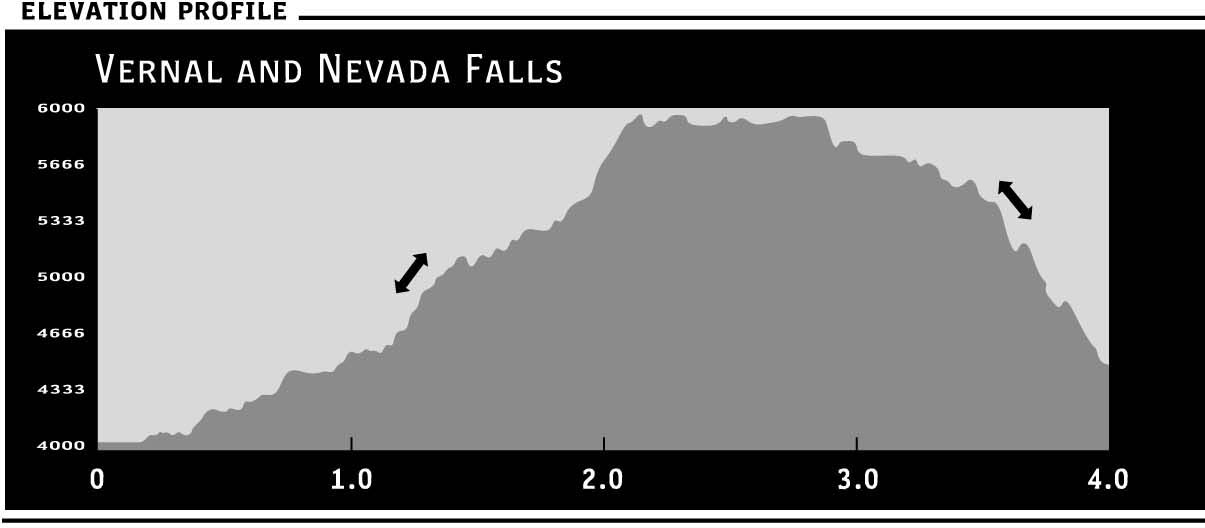1 Vernal and Nevada Falls
SCENERY: 
TRAIL CONDITION: 
CHILDREN: 
DIFFICULTY: 
SOLITUDE: 
DISTANCE: 8 miles
HIKING TIME: 4–6 hours
OUTSTANDING FEATURES: Vernal Falls, Nevada Falls, Emerald Pool, Silver Apron, Clark Point, sweeping views of the valley
A Yosemite classic, this one has it all: rushing waterfalls, verdant canyons, slabs of imposing granite, shady conifers, and inspiring views of the valley below. Nevada Falls drops 594 feet, making it the longest single leap of the Merced River, while Vernal Falls completes the journey with a 317-foot drop.
The trail is no secret, but it’s hard to blame the masses once you witness its dramatic charm. Start this walk early before it’s overrun with valley-floor visitors, as well as to avoid midday heat in the summer. Beginning on the John Muir Trail (JMT), this is a balloon loop. Start by climbing to a scenic footbridge and a thunderous view of Vernal Falls. Next, continue up the Mist Trail to the top of Nevada Falls. To return, loop back, descending on the more gradual JMT to rejoin your route at the footbridge.
DIRECTIONS: Yosemite can be entered via four main gateways: The BIG OAK FLAT ROAD ENTRANCE is on CA 120 West (Big Oak Flat Road) and is the closest western access to Tuolumne Meadows; the ARCH ROCK ENTRANCE on CA 140 (El Portal Road) is east of Merced and the safest bet in inclement weather, as it receives the least amount of snowfall; the SOUTH ENTRANCE is on CA 41 (Wawona Road), north of Fresno; and the weather-dependent TIOGA PASS ENTRANCE is on CA 120 East (Tioga Road) and is the closest eastern access to Tuolumne Meadows. Tioga Road is closed during the winter months due to snow, and sometimes doesn’t open until June or July. While the first three entrances are generally open year-round, all roads are subject to closure; check with the park service by phone at (209) 372-0200 or visit www.nps.gov/yose/planyourvisit/conditions.htm to determine current conditions.
The Happy Isles trailhead is in the southeastern part of Yosemite Valley, 1 mile past Curry Village. Year-round, day hikers are encouraged to leave their car in one of the day-use parking lots near Curry and Yosemite Villages and take the free shuttle bus to Shuttle Stop #16. There is a parking lot at Happy Isles, but it is often full in the summer months.
| GPS coordinates | HAPPY ISLES | |
| UTM zone (WGS84) | 11S | |
| Easting | 0274558 | |
| Northing | 4179230 | |
| Latitude | N 37°43′57.31″ | |
| Longitude | W 119°33′31.47″ |


 From the Happy Isles Shuttle Stop #16 (4,035 feet), walk along the road crossing the bridge over the Merced River and then turn right to follow the river south along the dusty, well-defined path. Follow the path as it ascends rather steeply along the river canyon and around Sierra Point, a rocky ledge on the southwest ridge of Grizzly Peak named after the Sierra Club. This is a fitting beginning to your hike, as John Muir was the first president elected to this conservation body in 1892. This is a crowded path, and you may be as amazed at the impressive variety of footwear—and the diverse smattering of accents from around the world—as you are with the granite boulders and distant waterfalls. As you ascend, pass through and above Happy Isles’s woodland of conifers and live-oak trees. Within 0.75 miles, reach your first viewing point of Vernal Falls. Together, the two falls are known as the Grand Staircase, as the Merced River dramatically steps its way down to the valley.
From the Happy Isles Shuttle Stop #16 (4,035 feet), walk along the road crossing the bridge over the Merced River and then turn right to follow the river south along the dusty, well-defined path. Follow the path as it ascends rather steeply along the river canyon and around Sierra Point, a rocky ledge on the southwest ridge of Grizzly Peak named after the Sierra Club. This is a fitting beginning to your hike, as John Muir was the first president elected to this conservation body in 1892. This is a crowded path, and you may be as amazed at the impressive variety of footwear—and the diverse smattering of accents from around the world—as you are with the granite boulders and distant waterfalls. As you ascend, pass through and above Happy Isles’s woodland of conifers and live-oak trees. Within 0.75 miles, reach your first viewing point of Vernal Falls. Together, the two falls are known as the Grand Staircase, as the Merced River dramatically steps its way down to the valley.
Camera-toting tourists in flip-flops and bikini tops crowd a wooden footbridge located here (4,600 feet). Just across the bridge look for a drinking fountain, restrooms, and an army of brazen snack-marauding squirrels.
From this vantage point, you can see the final plunge of the Merced River, which collects winter runoff from Mount Lyell, Yosemite’s highest peak at 13,114 feet. Witness the dramatic cascade year-round as water thunders down amid a frame of pine and cedar trees.
Shortly after leaving the footbridge, the trail reaches a junction. The Mist Trail continues on the left following the river along a rock-lined path through an area of lodgepole pines. The official John Muir Trail (JMT) turns to the right, taking a longer, more gradual climb before rejoining the shorter and steeper Mist Trail at the top of Nevada Falls.
Follow the Mist Trail eastward up-canyon with a spectacular view in the spring and early summer, living up to its name with watery mist drenching hikers as they make their way up hundreds of steep and sometimes slippery granite steps. Many hikers don raincoats for this section of the trail, but on a hot day the waterfall shower provides welcome relief. First reach the lower viewpoint of the falls, and then ascend the wet path upward, keeping your eyes peeled for rainbows in the spray.
At the top of Vernal Falls, a rail protects you from the sheer drop, hopefully keeping you from losing your camera, your lunch, or your life. Vernal means springtime, and the continual mist from the falls keeps the canyon lush and cool so that it’s perennially springtime in this corridor. Just upriver of the overlook lie the stunning wading pools and cascading waters of the Emerald Pool and Silver Apron, the latter so named for its color as a continual sheet of water streams over flat slabs of smooth granite.
It’s tempting to slide down the Silver Apron or swim here, but the current is incredibly strong and history shows repeatedly that disaster (as in death) is assured for those who attempt it. But a foot soak, head dunk, and scenic snack are all highly encouraged. You will find some composting restrooms upriver from the pools, just off the trail to the right.
Continue eastward and cross a wooden bridge over Diamond Cascade and then follow a relatively shaded gradual ascent, giving way to some exposed switchbacks in view of Nevada Falls. While the climb is steep up the rock walls, you have the prize in sight.
Reach a juncture with solar composting toilets and a series of trails leading to Half Dome, Cloud’s Rest, and Tenaya Lake. For JMT thru-hikers, this is where the route continues toward Tuolumne.
Turn right to follow the JMT southwest back toward the valley and reach a wide wading area. Before crossing the bridge, you can access an observation platform footbridge that allows you a glimpse into the river’s depths before it cascades violently over the edge. Many people miss this awesome overlook, which is worth a visit to really get a feel for the height. The iron-railed observation terrace is off a spur trail just north of the river. Nevada Falls flows through a narrow rock niche with tremendous force and then hits the wall, splitting into two different trajectories. After you’ve gotten your fill, rejoin the main trail and cross the wooden bridge (5,980 feet) to enjoy more dramatic views of the valley below.
Descend toward the valley and continue on the main path, ignoring cross trails to Illilouette Falls. Descend gradually, sometimes along a moist canyon wall that provides a bit of a light shower in the early season. This whole route was blasted from the canyon wall, and it’s an impressive feat of modern engineering.
When you reach Clark Point (5,481 feet), take in the views of the falls and the towering monoliths of the Liberty Cap, the back of Half Dome, and Mount Broderick. Stay left to follow the JMT down a series of steep switchbacks dotted with gnarled oak trees amid the granite.
As you approach the river, keep right to stay on the foot trail as a stock trail descends to the left. As you near the river, turn left to follow the JMT back to the bridge, waterfalls, and bathrooms at the base of the falls, and return the way you came to the shuttle-bus stop.
PERMIT INFORMATION: No permits necessary for day hikes